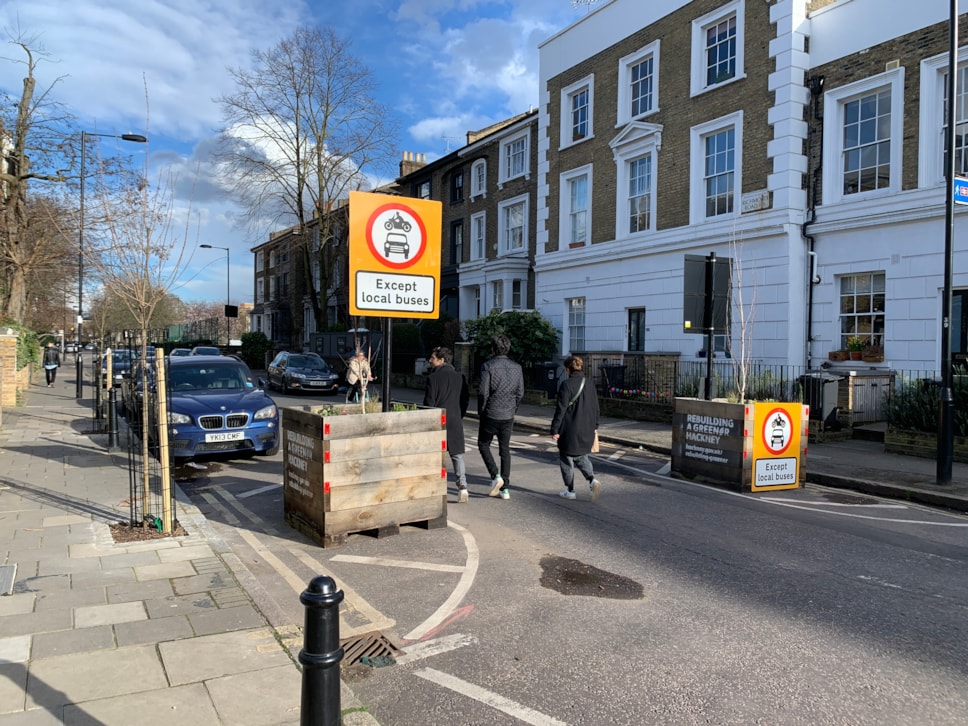
Traffic down in London Fields after low traffic neighbourhood
An initial analysis of traffic counts around Hackney’s London Fields low traffic neighbourhood (LTN) shows early signs of traffic reduction, with traffic down both in the neighbourhood itself and on boundary main roads.
Traffic inside London Fields LTN was down by an average of 44%, with traffic on boundary roads around the LTN also down by 21%, showing promising early indications of the ability of low traffic neighbourhoods to reduce traffic and support people to walk, shop and cycle locally.
The analysis uses traffic counts taken during November’s lockdown, when schools were open but overall traffic levels in Hackney were lower than pre-pandemic levels, and considers the impact of lockdown alongside reductions in traffic after the introduction of the low traffic neighbourhood. The counts were then compared with data from before the pandemic.
A benchmarking exercise to understand the impact of lockdown on traffic over the same time period shows there were traffic reductions of 16% nationally on urban roads, 15% on the A12 and an average of 14% reductions on main roads in the borough. The initial average reductions in and around London Fields low traffic neighbourhood exceed these benchmarks, but the Council is continuing to monitor traffic and evaluate the effect of the LTN.
The Council will be repeating traffic monitoring of its low traffic neighbourhoods during the early summer to ensure it is monitoring the full effects of the low traffic neighbourhood as the capital emerges from lockdown. This data will be published for residents to review.
The London Fields LTN was introduced last September, as part of the Council’s efforts to rebuild a greener Hackney, and support people to walk, shop and cycle in the wake of the pandemic.
The figures below show the changes in monitored levels of traffic on roads inside the low traffic neighbourhood:
- Richmond Road, east of Greenwood Road -94%
- Richmond Road, east of Queensbridge Road -89%
- Richmond Road, west of Queensbridge Road -90%
- Laurel Street +34%
- Forest Road, east of Beechwood Road +36%
- Middleton Road, west of Queensbridge Road -32%
- Lee Street, east of Stean Street -75%
The Council is aware of increases in traffic on Laurel Street and Forest Road and will continue to monitor these streets so it can address issues there.
The figures below show the changes in monitored levels of traffic on boundary roads outside the low traffic neighbourhood:
- Mare Street by Brenthouse Road -27%
- Graham Road, west of Mare Street -12%
- Dalston Lane, east of Beechwood Road -35%
- Kingsland Road, north of Richmond Road -13%
- Queensbridge Road, north of Richmond Road -19%
- Queensbridge Road, north of Whiston Road -25%
- Whiston Road, west of Queensbridge Road -18%
Residents can have their say online at: https://rebuildingagreenerhackney.commonplace.is/ or by writing for free to the Council at ‘Freepost Streetscene’.
Read the Council’s full analysis of these interim results.
Previous Council analysis of the effect of low traffic neighbourhoods on boundary roads, showed no significant effect immediately following their introduction: https://news.hackney.gov.uk/ltn-traffic-data.
These interim figures show a broad reduction in traffic across the London Fields area, helping to rebuild a greener Hackney for our residents and supporting them to walk, shop and cycle locally.
Some of the figures are stark, with around 1,000 vehicles now using Richmond Road each day, a road that was previously blighted by 9,000 cars daily.
What’s encouraging at this stage is that there are also reductions in traffic on boundary main roads too - although there are roads where residents have concerns that we are looking at very closely. We’ve always been clear that we’re happy to tweak schemes where appropriate so we’ll continue to look at the data and make changes where necessary.
I’d encourage residents to continue to have their say online or in writing - we’ve extended engagement on all schemes so people can see how the trials continue to work as we emerge from lockdown.Cllr Mete Coban MBE, Cabinet Member for Energy, Waste, Transport and Public Realm
